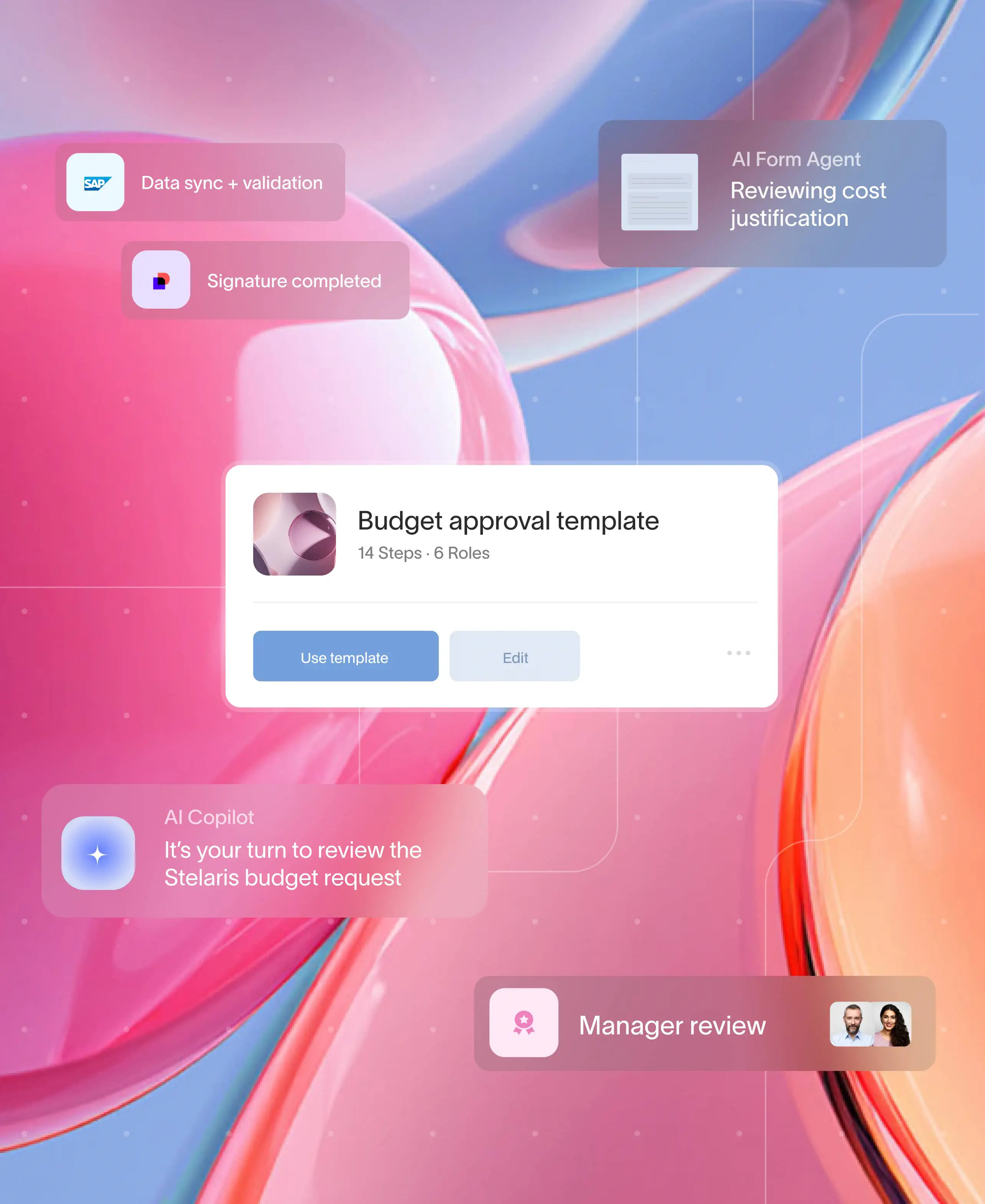
At a glance
- Inboxes expose sensitive files to phishing and forwarding, bury versions in long threads, hit size limits, and create compliance gaps, which slow approvals and increase errors.
- A secure, centralized workspace with encryption, MFA, role-based access, and full audit logs. It consolidates messages and files, removes size limits, and keeps a single, searchable source of truth (HIPAA/GDPR/FINRA-ready).
- Faster reviews and approvals with in-portal comments, versioning, and notifications; audit-ready trails; a polished client experience. Proven across finance, legal, healthcare, creative, and education.
- Moxo’s branded client portals, approvals engine, and audit trails replace email bottlenecks so work moves in hours, not days. The next step is to transition key workflows to a secure portal to control data, speed delivery, and build client trust.
The file-sharing problem nobody talks about
Most businesses default to email for file exchanges. It's familiar, it's fast, and everyone has it.
Nine out of ten cyberattacks start in the inbox. Once you send a file, you lose control over who forwards it, where it is stored, and how it is handled. Email threads bury files in endless “Re: Re:” chains, create duplicate versions, and delay approvals.
Client portal file sharing fixes these problems at their root. It provides you and your clients with a secure, centralized, and branded space where you can exchange, comment on, and approve documents in one place. You keep every interaction encrypted, tracked, and easy to retrieve.
Firms in finance, law, healthcare, creative, and education use portals to run efficient, compliant, and client-friendly operations instead of fighting against email chaos.
What is client portal file sharing
The client portal is a secure, web-based platform that centralizes all client-related documents in a single, password-protected location. You store, send, and manage files in one place, and you control exactly who accesses them.
Core technical capabilities
- Enterprise-grade encryption: AES-256 encryption at rest and SSL/TLS in transit to meet banking and healthcare security standards.
- Compliance-ready audit logs: Automatic tracking of every file action for HIPAA, GDPR, FINRA, and SOX compliance requirements.
- Advanced access controls: Role-based permissions, multi-factor authentication, and IP restrictions for granular security.
- Integration ecosystem: Native connections to CRMs, accounting software, project management tools, and cloud storage platforms.
- White-label customization: Full branding control with custom domains, logos, colors, and user interface elements.
- Scalable infrastructure: Enterprise-grade uptime, unlimited file storage, and support for thousands of concurrent users.
Common use cases for client portal file sharing
Businesses use client portals to manage critical document workflows more securely and efficiently. Common use cases include:
- Secure delivery: Send financial statements, legal contracts, or sensitive reports with end-to-end encryption.
- Client uploads: Enable clients to upload forms, identification scans, or supporting documents directly through secure document collection workflows, avoiding insecure email attachments.
- Review and approval: Route documents through defined, time-stamped review steps, ensuring a clear chain of custody.
- Project documentation: Centralize all project-related files, design assets, datasets, and lab results in one organized repository.
- Audit readiness: Maintain complete access and activity logs to support internal or external audits.
How to use a client portal: Step-by-step workflow
Here's how you and your clients work together in a portal environment:
- Initial setup: Create your branded portal workspace, organize folder structures, and invite team members and clients.
- Client onboarding: Send secure login credentials, guide clients through the interface, and configure their specific access permissions.
- File uploads: Drag and drop documents directly into organized folders, with automatic virus scanning and format validation.
- Permission assignment: Define who can view, edit, download, or share specific files based on project roles and security requirements.
- Real-time collaboration: Clients and team members add comments, request changes, and provide approvals directly on documents.
- Instant alerts: Everyone receives notifications about file updates, comments, or approvals.
- Progress tracking: Monitor project status, file versions, and approval workflows through a centralized dashboard.
Why are client portals better than email
Email feels convenient until it becomes expensive. Here's where email breaks down and portals excel:
Security: email is a sitting duck
Phishing, malicious attachments, and credential theft all start in the inbox. Once you hit send, you lose control. Recipients can forward files to anyone, store them anywhere, and you'll never know.
Client portals encrypt files end-to-end, require multi-factor authentication, and let you revoke access instantly. When a project ends or a client relationship changes, you cut off access with one click.
Organization: email creates chaos
Email threads bury files in endless "Re: Re:" chains. Multiple people send different versions. Someone always works from the wrong file. Approvals stall because stakeholders can't find the latest version.
Portals store every file in a searchable, organized repository. Version control ensures everyone works from the same document. No more "final_final_v3" disasters.
Collaboration: email fragments everything
Email forces you to piece together feedback from scattered conversations. Comments get lost in threads. Approval status is unclear. Decision-makers drop out of the loop.
Portals keep all feedback, approvals, and document edits in one location. Every stakeholder sees the same information. Progress is transparent.
Client experience: email feels amateur
Clients dig through old messages hunting for files. Large attachments bounce back. Important documents land in spam folders. The whole experience screams "disorganized."
Portals offer a polished, branded environment where clients find what they need instantly. No file size limits. No hunting through email history. Professional from start to finish.
Speed: email creates bottlenecks
Manual follow-ups. Lost attachments. Delayed notifications. Email turns simple approvals into multi-day adventures.
Portals use instant notifications and automated workflows to replace manual handoffs, cutting project timelines by up to half.
Which industries benefit most from client portal file sharing
Some industries see especially high returns when they replace email with client portals.
Accounting and finance
Exchange tax documents, statements, and audit materials securely. K&A Mobile Tax Services reduced processing errors and improved client rankings using Moxo’s mobile client hub.
Legal services
Share contracts, case files, and evidence while keeping a verifiable chain of custody. Veon Szu Law Firm increased efficiency by 80% after adopting a portal for case updates and e-signatures.
Creative agencies
Preview, annotate, and approve large design and video files in-platform. 1852 Media grew client capacity by 30% per account manager through centralized creative approvals.
Healthcare
Send patient records, lab results, and treatment plans securely while meeting HIPAA requirements. ChenMed has improved appointment adherence by 27% using a patient engagement portal.
Education and training
Deliver course materials, grades, and feedback securely to students and parents. Hibernia College achieved a 97% retention rate after launching a collaborative learning portal.
How to choose the right client portal
When evaluating platforms, focus on essential client portal features that align with your industry requirements. Prioritize:
- Security with end-to-end encryption, MFA, and precise access controls.
- Ease of use with an intuitive interface that encourages client adoption.
- Branding with a consistent, professional appearance that matches your identity.
- Integrations with CRM, project management, and accounting tools.
- Scalability to handle more files, users, and features as you grow.
- Support with reliable onboarding and responsive customer service.
How Moxo transforms client file sharing
Email-based file sharing fragments communication, slows approvals, and leaves teams chasing updates. Manual approval chains stall projects, create bottlenecks, and frustrate clients who expect faster turnaround.
Moxo removes those bottlenecks by centralizing communication, automating approvals, and housing every document in one secure, branded hub. Teams and clients work from the same place, with every action tracked and every step streamlined.
- Approvals engine: Automates multi-step, role-based approvals so no request gets stuck waiting for sign-off.
- Audit trails: Captures every interaction for complete compliance visibility and easy reporting.
- Client portals: Provide a branded, all-in-one space for clients to upload documents, sign forms, and receive real-time updates.
BNP Paribas cut onboarding time by 50% by unifying messaging, document exchange, and digital signatures within their Moxo-powered MyWealth app.
With Moxo, approvals move in hours, not days, freeing your team to focus on delivering value instead of chasing paperwork.
Get started with Moxo today and see how effortless client collaboration can be.
How to transition from email to a client portal
Follow a structured rollout to maximize adoption.
- Review current workflows to identify bottlenecks and risks.
- Choose a portal that fits your compliance, branding, and integration needs.
- Onboard high-value clients first to create early wins.
- Provide training and rapid-response support during the first month.
- Track improvements in turnaround times, approval rates, and client satisfaction.
Conclusion
Client portal file sharing replaces the inefficiency and risk of email with a secure, centralized, and branded environment. You keep control of sensitive files, move projects faster, and deliver a client experience that builds trust.
Moxo combines robust security, intuitive design, and workflow automation to help professional service firms operate at their best. If you handle regulated data or complex client deliverables, the smartest time to move beyond email is now.
Get started with Moxo today and see how effortless client collaboration can be.
FAQs
What is a client portal for file sharing?
A secure, branded platform where you exchange, store, and manage documents with clients, replacing email with encrypted sharing and full audit trails.
How is a client portal safer than email?
It encrypts files, uses MFA, and applies granular permissions with complete activity logs, capabilities that email does not offer.
Can I share large files through a client portal?
Yes. Portals like Moxo handle large uploads without size limits and notify clients instantly when files are ready.
Do clients need technical skills to use a portal?
No. Most portals offer intuitive, browser-based access with drag-and-drop uploads and mobile compatibility.
Which industries benefit most?
Finance, legal, healthcare, technology, and education, or any sector that exchanges sensitive, high-volume documents.





